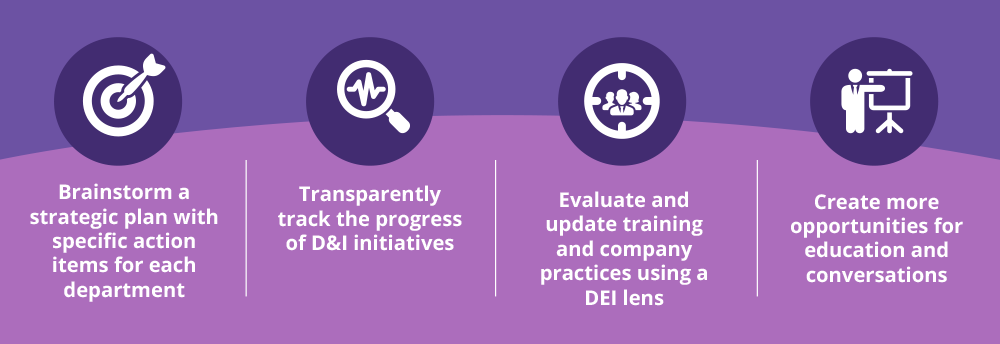02/25/2021
When I joined Sendero, I was excited about the opportunities outside of our client work that the company offered – including employee-led committees and community service projects. As soon as I started, I joined the Diversity & Inclusion committee since their goals most aligned with my passions.
As the country went through a summer of civil rights protests last year, we saw companies champion D&I in many different ways:
- NBA: Donating $300 million over the next 10 years to economically empower Black communities
- Airbnb: Partnering with civil rights & privacy organizations to transparently study racial discrimination and combat it
- Ben & Jerry’s: Focusing on educating through social media posts and articles on their website
Sendero showed a genuine desire to be a part of positive change and wanted a better understanding of the roots of the complex issues of systemic racism. We knew we wanted to be a part of the solution, which required us to take further steps.
 Step 1: Systemic Oppression Education
Step 1: Systemic Oppression Education
To understand systemic racism, we need to first distinguish it from mere prejudice and discrimination. Prejudice is pre-judgment about another person based on the social groups to which that person belongs. All humans have prejudice, and we cannot avoid it. Discrimination is an action based on prejudice. Whereas racism is a structure of oppression backed by the power of legal authority with far-reaching implications that function independently from the prejudiced discriminatory actions at an individual level. In order for there to be a collective push toward positive change, we must all understand what systemic racism is and how the status quo is complicit with systemic racism.
We knew many of our employees wanted to learn and grow in their understanding, so as a Diversity & Inclusion committee we created the opportunity. The committee wanted to design a space where employees could feel safe to listen, learn, and share their reflections. We started off by considering everyone’s level of education on these topics and decided that before bringing us all together, we should give time and resources for preparation. We also thought about how to best provide educational opportunities while being mindful of not placing the burden primarily on our people of color (POC).
Step 2: Diversity & Inclusion All-Company Forum
With the preparation completed, we executed a “listening session”. The session served as a great opportunity for the entire company to consume information about systemic racism and incorporate their learnings into conversations that helped connect the dots from individual stories of racial bias, exclusion, and trauma, to larger systemic issues.
We guided the conversation with the discussion questions below:
- What do you think people need to learn?
- What can we do differently?
- What are your hopes for the future as we at Sendero walk into the new “normal”?
We practiced building our stamina for conversations about racism by breaking out into virtual small groups and participating in conversations using our learned vocabulary and sharing our reflections. By practicing unpacking terms such as systemic racism, we became more familiar as a company directly discussing the uncomfortable truth. The session was valuable because it empowered everyone to educate themselves with the resources provided along with the social accountability component of participating in reflective discussions with peers.
Step 3: Organize Feedback, Create a Plan, and Take Action
Businesses can be a part of this positive change, but it starts with foundational education. If you want your company’s culture to be an advocate of diversity, fairness, and inclusivity, it requires having a collective understanding of the obstacles at play.
Below is the plan we executed to improve our understanding as a company and some points to consider if you or your company wants to do something similar:
- Engage a Diversity, Equity, and Inclusion (DEI) consultant to help plan and moderate an event
- Provide a variety of bite-sized media resources for employees to review prior to the event
- Ask leadership to encourage attendance and set the tone of importance for the event
- Create safe spaces by making small break-out discussion groups with intention (mix of people from different levels; no direct management to employee relationships in a group)
- Provide discussion questions based on the educational content
- Include Diversity & Inclusion Committee members or a volunteer in each break out room to capture feedback and ideas
- Send out a post-event survey for additional feedback
Once you’re equipped with a more in-depth education you come to understand it is not enough to be “not racist”. We must be actively “anti-racist” by taking steps to learn and grow in our understanding of systemic racism and creating opportunities for others. The listening session provided a platform to capture the desires of the employees for the future of the company in terms of diversity, equity, and inclusion. The thoughtful preparation beforehand helped our people get on the same page and initiate crucial conversations which helped establish our next steps:

It is important to remember that each of us makes up our company’s culture. To ensure our culture embodies diversity, equity, and inclusivity takes a long-term, all-company commitment. If you want to be a part of lasting change for diversity and inclusion in your organization, remember that change is possible when we come together to learn and take action.
